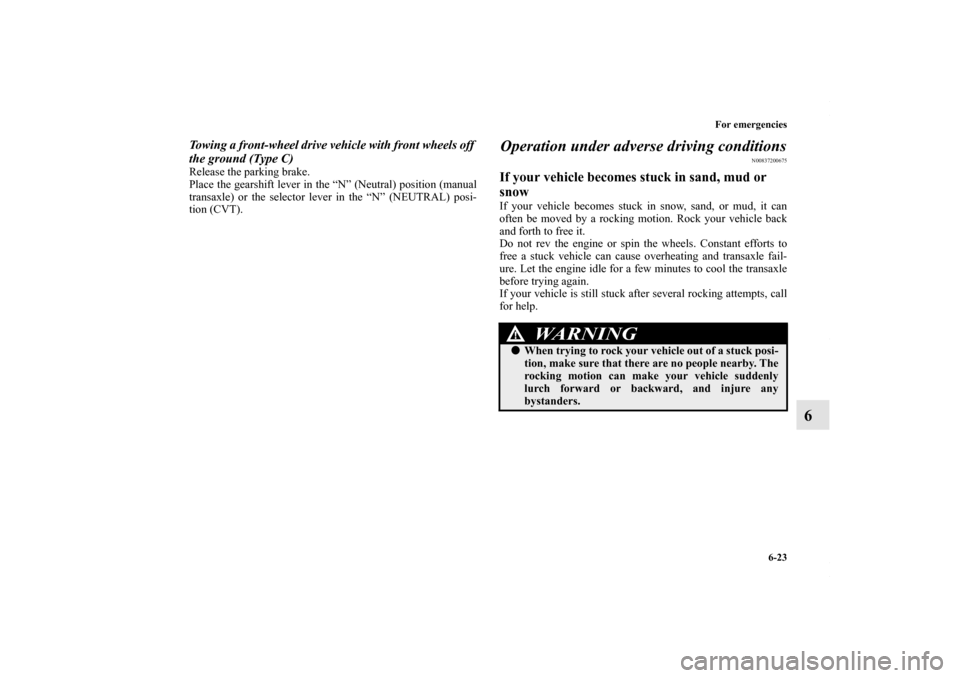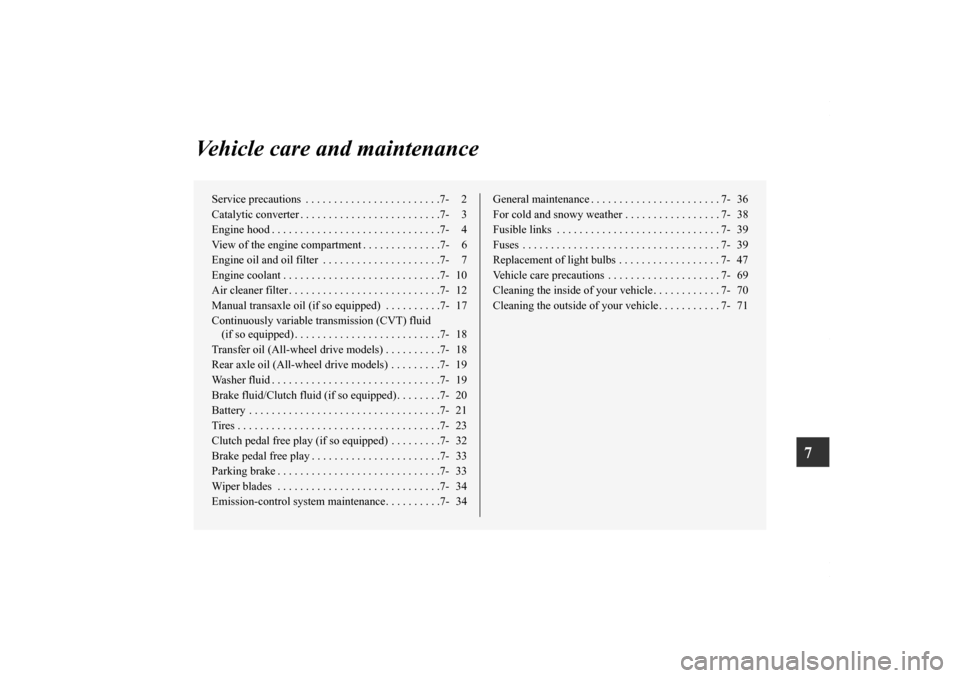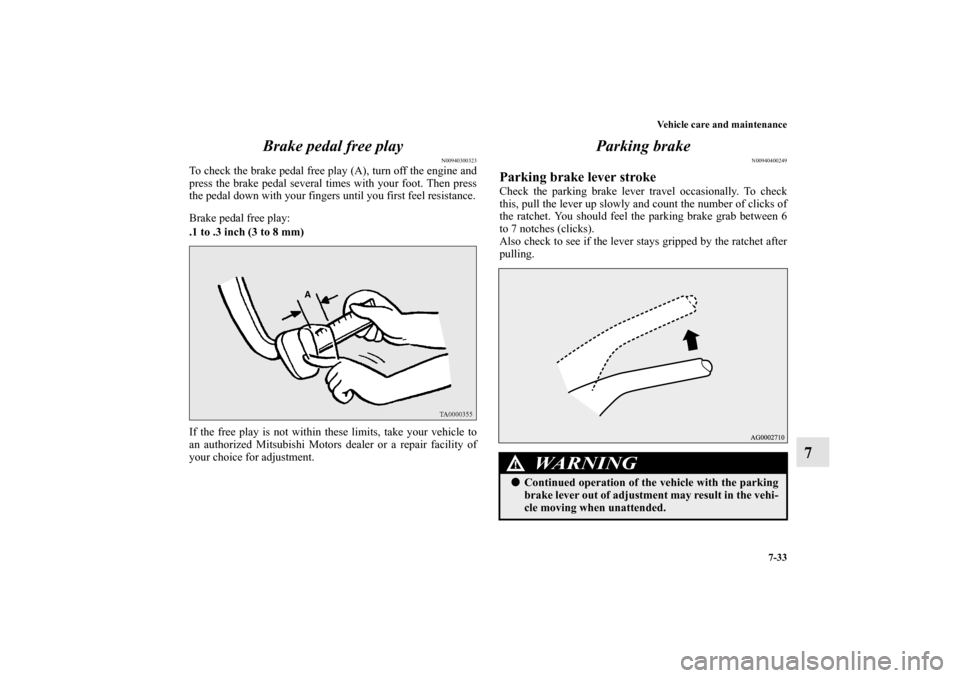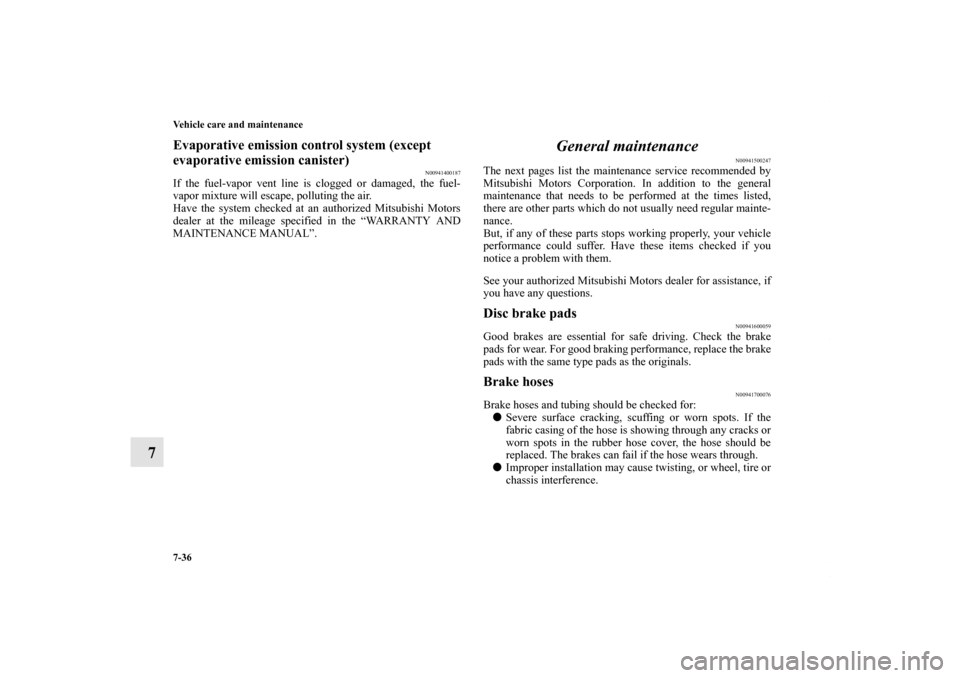Page 483 of 602
6-8 For emergencies
6
JackBefore removing the jack, lift up the luggage floor board.
How to change a tire
N00836900792
Before changing a tire, first stop your vehicle in a safe, flat
location.1. Park the vehicle on level and stable ground.
2. Set the parking brake firmly.
3. On vehicles equipped with manual transaxle, stop the engine and move the gearshift lever to the “R” (Reverse)
position.
On vehicles equipped with continuously variable trans-
mission (CVT), move the selector lever to the “P”
(PARK) position, and stop the engine.
4. Turn on the hazard flashers and set up a warning triangle, flashing signal light, etc., at an adequate distance from the
vehicle, and have all your passengers leave the vehicle.
WARNING
!� The jack should not be used for any purpose other
than to change a tire.�Never get under the vehicle or put any portion of
your body under the vehicle while it is supported by
the jack.
BK0150700US.book 8 ページ 2012年3月22日 木曜日 午後6時46分
Page 498 of 602

For emergencies6-23
6
Towing a front-wheel drive vehicle with front wheels off
the ground (Type C)Release the parking brake.
Place the gearshift lever in the “N” (Neutral) position (manual
transaxle) or the selector lever in the “N” (NEUTRAL) posi-
tion (CVT).
Operation under adverse driving conditions
N00837200675
If your vehicle becomes stuck in sand, mud or
snowIf your vehicle becomes stuck in snow, sand, or mud, it can
often be moved by a rocking motion. Rock your vehicle back
and forth to free it.
Do not rev the engine or spin the wheels. Constant efforts to
free a stuck vehicle can cause overheating and transaxle fail-
ure. Let the engine idle for a few minutes to cool the transaxle
before trying again.
If your vehicle is still stuck after several rocking attempts, call
for help.
WARNING
!�When trying to rock your vehicle out of a stuck posi-
tion, make sure that there are no people nearby. The
rocking motion can make your vehicle suddenly
lurch forward or backward, and injure any
bystanders.
BK0150700US.book 23 ページ 2012年3月22日 木曜日 午後6時46分
Page 499 of 602

6-24 For emergencies
6
On wet roadsOn snowy or icy roads
�When driving on a road covered with snow or ice, use
snow tires. Tire chains cannot be used on your vehicle.
There may be state or local regulations about using snow
tires. Always check the regulations in your local area
before using them. Refer to “Snow tires” on page 7-32
and “Tire chains” on page 7-32.
� Drive slowly. Do not make sudden starts or stops, sharp
turns, or slam on the brakes.
� Allow extra distance between your vehicle and the vehicle
in front of you, and avoid sudden braking.
� If a skid occurs when the accelerator pedal is depressed,
take your foot off the pedal. Steer gently in the direction
of the skid.
� Your vehicle is equipped with an anti-lock braking system
(ABS). Hold the brake pedal down firmly and keep it
depressed. Do not pump the brake pedal which will result
in reduced braking performance.
� After parking on snowy or icy road, it may be difficult to
move your vehicle due to freeze-up of the brake. Depress
the accelerator pedal little by little to move the vehicle
after confirming safety of the vehicle.
CAUTION
!�Avoid flooded roads. Water is often deeper than it
looks, and you could be seriously hurt by driving
into flood water.�When driving in rain, on water-covered roads, or
through a car wash, water could get into the brake
discs and make them fail temporarily. In such cases,
lightly press the brake pedal to see if they are work-
ing properly. If they are not, press the pedal lightly
several times while driving to dry the brake pads or
linings, then check them again.�When driving in rain, a layer of water may form
between the tires and the road surface (hydroplan-
ing). This loosens your tires’ grip on the road, mak-
ing it difficult to steer or brake properly. When
driving on a wet road:
• Drive your vehicle at a safe speed.
• Do not drive on worn tires.
• Always keep the tires at the correct inflation pres-
sures.
CAUTION
!� Do not depress the accelerator pedal rapidly. The
vehicle could start moving when it breaks free from
the ice, possibly resulting in an accident.
BK0150700US.book 24 ページ 2012年3月22日 木曜日 午後6時46分
Page 502 of 602

7
Vehicle care and maintenance
Service precautions . . . . . . . . . . . . . . . . . . . . . . . .7- 2
Catalytic converter . . . . . . . . . . . . . . . . . . . . . . . . .7- 3
Engine hood . . . . . . . . . . . . . . . . . . . . . . . . . . . . . .7- 4
View of the engine compartment . . . . . . . . . . . . . .7- 6
Engine oil and oil filter . . . . . . . . . . . . . . . . . . . . .7- 7
Engine coolant . . . . . . . . . . . . . . . . . . . . . . . . . . . .7- 10
Air cleaner filter . . . . . . . . . . . . . . . . . . . . . . . . . . .7- 12
Manual transaxle oil (if so equipped) . . . . . . . . . .7- 17
Continuously variable transmission (CVT) fluid (if so equipped) . . . . . . . . . . . . . . . . . . . . . . . . . .7- 18
Transfer oil (All-wheel drive models) . . . . . . . . . .7- 18
Rear axle oil (All-wheel drive models) . . . . . . . . .7- 19
Washer fluid . . . . . . . . . . . . . . . . . . . . . . . . . . . . . .7- 19
Brake fluid/Clutch fluid (if so equipped) . . . . . . . .7- 20
Battery . . . . . . . . . . . . . . . . . . . . . . . . . . . . . . . . . .7- 21
Tires . . . . . . . . . . . . . . . . . . . . . . . . . . . . . . . . . . . .7- 23
Clutch pedal free play (if so equipped) . . . . . . . . .7- 32
Brake pedal free play . . . . . . . . . . . . . . . . . . . . . . .7- 33
Parking brake . . . . . . . . . . . . . . . . . . . . . . . . . . . . .7- 33
Wiper blades . . . . . . . . . . . . . . . . . . . . . . . . . . . . .7- 34
Emission-control system maintenance. . . . . . . . . .7- 34 General maintenance . . . . . . . . . . . . . . . . . . . . . . . 7- 36
For cold and snowy weather . . . . . . . . . . . . . . . . . 7- 38
Fusible links . . . . . . . . . . . . . . . . . . . . . . . . . . . . . 7- 39
Fuses . . . . . . . . . . . . . . . . . . . . . . . . . . . . . . . . . . . 7- 39
Replacement of light bulbs . . . . . . . . . . . . . . . . . . 7- 47
Vehicle care precautions . . . . . . . . . . . . . . . . . . . . 7- 69
Cleaning the inside of your vehicle . . . . . . . . . . . . 7- 70
Cleaning the outside of your vehicle . . . . . . . . . . . 7- 71
BK0150700US.book 1
ページ 2012年3月22日 木曜日 午後6時46分
Page 507 of 602
7-6 Vehicle care and maintenance
7
NOTE�If this does not close the engine hood properly, drop it
again from a slightly higher position.
� Do not push down strongly on the engine hood. Depend-
ing on how strongly or where you push down, you could
create a dent in the vehicle body.
� If you drive with the engine hood left open, warning dis-
play is displayed on the information screen in the multi-
information display.
View of the engine compartment
N00937600625
Type 1 Type 2
1- Engine oil level dipstick
2- Engine oil filler cap
3- Air cleaner filter
4- Brake fluid/Clutch fluid reservoir (if so equipped)
5- Windshield and rear window washer fluid reservoir
6- Engine coolant reserve tank
7- Radiator cap
8- Battery
BK0150700US.book 6 ページ 2012年3月22日 木曜日 午後6時46分
Page 521 of 602

7-20 Vehicle care and maintenance
7Brake fluid/Clutch fluid
(if so equipped)
N00938700245
The brake fluid and the clutch fluid share the reservoir tank.To check the fluid levelThe fluid level must be between the “MAX” and “MIN” marks
on the reservoir.
The fluid level falls slightly with wear of the brake pads, but
this does not indicate any abnormality.
The fluid in the master cylinder should be checked when doing
other work under the engine hood. The brake system should
also be checked for leaks at the same time.
If the fluid level falls markedly in a short length of time, it indi-
cates leaks from the brake system.
If this occurs, have the vehicle checked by an authorized
Mitsubishi Motors dealer or a repair facility of your choice.
Fluid typeUse the brake fluid conforming to DOT 3 or DOT 4. The reser-
voir cap must be tightly sealed to keep dirt and water out.
MAX
MIN
CAUTION
!�
Do not let any petroleum-based fluid touch, mix
with, or get into the brake fluid. This will damage
the seals.�Be careful when handling brake fluid. It can damage
painted surfaces.�Use only the listed brake fluid. Different brands of
brake fluid have different additives, and these can
cause a chemical reaction. Do not mix brands of
brake fluid.�Keep the reservoir tank cap closed to keep the brake
fluid from evaporating.
BK0150700US.book 20 ページ 2012年3月22日 木曜日 午後6時46分
Page 534 of 602

Vehicle care and maintenance7-33
7
Brake pedal free play
N00940300323
To check the brake pedal free play (A), turn off the engine and
press the brake pedal several times with your foot. Then press
the pedal down with your fingers until you first feel resistance.
Brake pedal free play:
.1 to .3 inch (3 to 8 mm)
If the free play is not within these limits, take your vehicle to
an authorized Mitsubishi Motors dealer or a repair facility of
your choice for adjustment.
Parking brake
N00940400249
Parking brake lever strokeCheck the parking brake lever travel occasionally. To check
this, pull the lever up slowly and count the number of clicks of
the ratchet. You should feel the parking brake grab between 6
to 7 notches (clicks).
Also check to see if the lever stays gripped by the ratchet after
pulling.
WARNING
!�
Continued operation of the vehicle with the parking
brake lever out of adjustment may result in the vehi-
cle moving when unattended.
BK0150700US.book 33 ページ 2012年3月22日 木曜日 午後6時46分
Page 537 of 602

7-36 Vehicle care and maintenance
7
Evaporative emission control system (except
evaporative emission canister)
N00941400187
If the fuel-vapor vent line is clogged or damaged, the fuel-
vapor mixture will escape, polluting the air.
Have the system checked at an authorized Mitsubishi Motors
dealer at the mileage specified in the “WARRANTY AND
MAINTENANCE MANUAL”.
General maintenance
N00941500247
The next pages list the maintenance service recommended by
Mitsubishi Motors Corporation. In addition to the general
maintenance that needs to be performed at the times listed,
there are other parts which do not usually need regular mainte-
nance.
But, if any of these parts stops working properly, your vehicle
performance could suffer. Have these items checked if you
notice a problem with them.
See your authorized Mitsubishi Motors dealer for assistance, if
you have any questions.Disc brake pads
N00941600059
Good brakes are essential for safe driving. Check the brake
pads for wear. For good braking performance, replace the brake
pads with the same type pads as the originals.Brake hoses
N00941700076
Brake hoses and tubing should be checked for:� Severe surface cracking, scuffing or worn spots. If the
fabric casing of the hose is showing through any cracks or
worn spots in the rubber hose cover, the hose should be
replaced. The brakes can fail if the hose wears through.
� Improper installation may cause twisting, or wheel, tire or
chassis interference.
BK0150700US.book 36 ページ 2012年3月22日 木曜日 午後6時46分